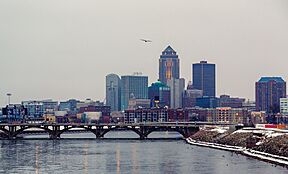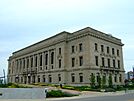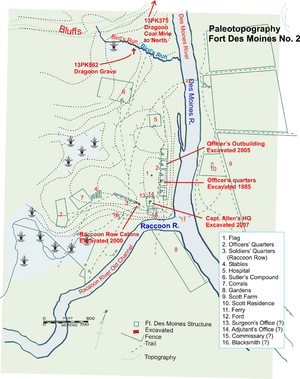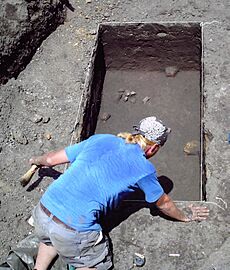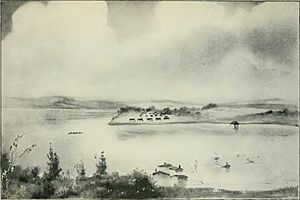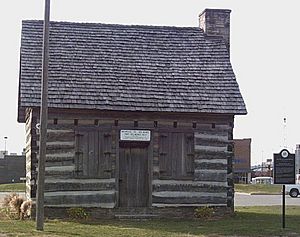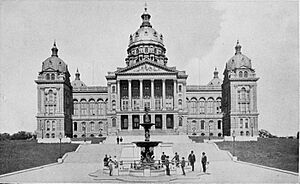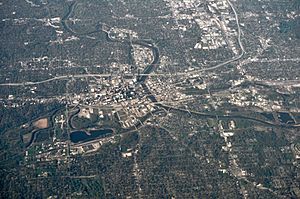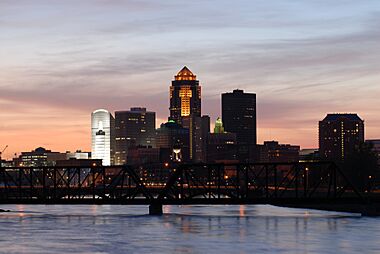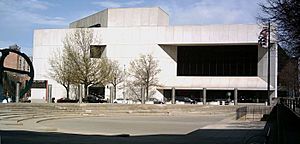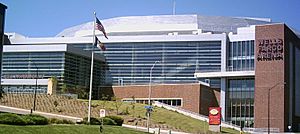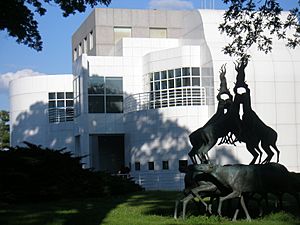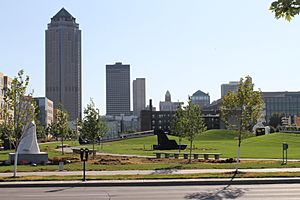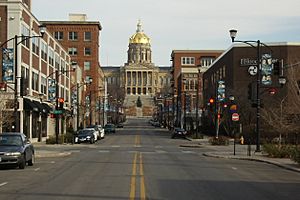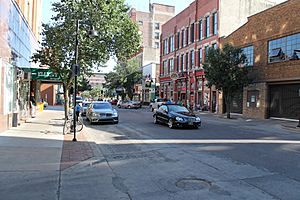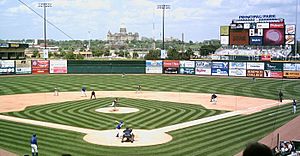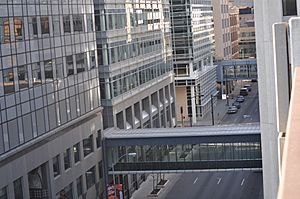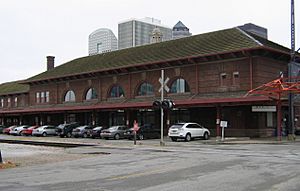Des Moines, Iowa facts for kids
Quick facts for kids
Des Moines
|
|||||
|---|---|---|---|---|---|
|
The skyline of Downtown Des Moines
Greater Des Moines Botanical Garden
|
|||||
|
|||||
| Nickname(s):
"Niceville USA", "Hartford of the West"
|
|||||
| Country | |||||
| State | |||||
| Counties | Polk, Warren | ||||
| Founded | 1843 | ||||
| Incorporated | September 22, 1851 | ||||
| Government | |||||
| • Type | Council–manager | ||||
| • Body | Des Moines City Council | ||||
| Area | |||||
| • State capital city | 90.70 sq mi (234.92 km2) | ||||
| • Land | 88.18 sq mi (228.38 km2) | ||||
| • Water | 2.52 sq mi (6.54 km2) | ||||
| Elevation | 873 ft (266 m) | ||||
| Population
(2020)
|
|||||
| • State capital city | 214,133 | ||||
| • Rank | US: 111th IA: 1st |
||||
| • Density | 2,428.39/sq mi (937.60/km2) | ||||
| • Urban | 542,486 (US: 78th) | ||||
| • Urban density | 2,413.8/sq mi (932.0/km2) | ||||
| • Metro | 709,466 (US: 81st) | ||||
| • CSA | 890,322 (US: 65th) | ||||
| Time zone | UTC−6 (CST) | ||||
| • Summer (DST) | UTC−5 (CDT) | ||||
| ZIP Codes |
50301-50340-50310-50316
|
||||
| Area code | 515 | ||||
| FIPS code | 19-21000 | ||||
| GNIS feature ID | 465961 | ||||
Des Moines (![]() i/dəˈmɔɪn/ DƏ-moyn) is the capital city of Iowa. It is also the most populated city in the state. Des Moines is the main city of Polk County, with some parts reaching into Warren County.
i/dəˈmɔɪn/ DƏ-moyn) is the capital city of Iowa. It is also the most populated city in the state. Des Moines is the main city of Polk County, with some parts reaching into Warren County.
The city was officially started on September 22, 1851, and was first called Fort Des Moines. This name was shortened to "Des Moines" in 1857. The city is located on and named after the Des Moines River. The river's name likely came from an old French name, Rivière des Moines, which means "River of the Monks".
In 2020, about 214,133 people lived in Des Moines. The larger area around Des Moines, which includes six counties, is home to over 709,466 people. This makes it the largest metropolitan area completely within Iowa.
Des Moines is a big center for the United States' insurance industry. Many companies that deal with money and publishing also have their main offices or large operations here. For example, Principal Financial Group and Wellmark Blue Cross Blue Shield are based in Des Moines. Other big companies like Wells Fargo, Microsoft, and Facebook also have important facilities in the area.
Des Moines is very important in U.S. presidential politics. Because it's the state capital, it hosts the first caucuses for choosing presidential candidates. Many candidates set up their campaign offices in Des Moines. People say it's one of the best places to see presidential candidates up close.
Contents
- History of Des Moines
- Geography of Des Moines
- People of Des Moines
- Economy of Des Moines
- Arts and Culture in Des Moines
- Sports in Des Moines
- Parks and Recreation in Des Moines
- Education in Des Moines
- Media in Des Moines
- Transportation in Des Moines
- Sister Cities of Des Moines
- Images for kids
- See also
History of Des Moines
How Des Moines Got Its Name
Des Moines gets its name from Fort Des Moines, a fort built between 1843 and 1846. The fort was named after the Des Moines River. French explorers gave the river its name, Des Moines, which means "from the monks" or "of the monks".
One idea is that "Des Moines" refers to a group of French Trappist monks. In the 1600s, these monks lived in simple huts on a place called Monks Mound at Cahokia. This ancient city was a major center for the Mississippian culture, located far from the Des Moines River in what is now Illinois.
Early People in the Des Moines Area
Archaeologists have found signs that people have lived near where the Des Moines and Raccoon Rivers meet for at least 7,000 years. Many old living areas have been found in downtown Des Moines. For example, in 2010, a 7,000-year-old site called the "Palace" was discovered. It had well-preserved house remains and many graves, with over 6,000 artifacts found.
At least three villages, dating from about 1300 to 1700 AD, were located in or near what is now downtown Des Moines. Early settlers also saw 15 to 18 ancient Native American mounds in the area. Sadly, all of these mounds have been destroyed as the city grew.
Building Fort Des Moines
Des Moines began in May 1843. Captain James Allen oversaw the building of a fort where the Des Moines and Raccoon Rivers meet. Captain Allen wanted to call it Fort Raccoon, but the U.S. War Department chose Fort Des Moines instead.
The fort was built to control the Sauk and Meskwaki peoples. The government had moved these groups from their traditional lands in eastern Iowa to this area. The fort was closed in 1846 after the Sauk and Meskwaki were moved out of the state.
After the official removal, the Meskwaki people continued to return to Des Moines until around 1857.
How Des Moines Grew
Settlers began to live in the abandoned fort and nearby areas. In May 1846, the state government made Fort Des Moines the main town of Polk County.
In May 1851, a big flood destroyed much of the town. The Des Moines and Raccoon Rivers rose very high, covering the land and washing away homes and farms. The city then had to rebuild itself.
On September 22, 1851, Des Moines officially became a city. In 1857, its name was shortened from "Fort Des Moines" to "Des Moines". It also became the second state capital, taking over from Iowa City. The city grew slowly during the Civil War, but it expanded quickly after a railroad line was finished in 1866.
By 1880, Des Moines had 22,408 people, making it Iowa's largest city. It has been the most populated city in Iowa ever since.
Changes and Rebuilding in Des Moines
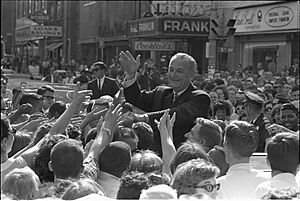
Around the year 1900, Des Moines started a "City Beautiful" project. This project built large, fancy public buildings and fountains along the Des Moines River. Examples still standing today include the old Des Moines Public Library building and the City Hall.
In the 1930s, during the Great Depression, beautiful stone railings were built along the Des Moines and Raccoon Rivers. This project helped give jobs to local people and improve the city. However, in the 1950s, the city started to decline as industries left.
Since the late 1980s, Des Moines has bounced back. It changed from a city with many factory jobs to one with more office and professional jobs.
Like many big cities, Des Moines' population started moving to the suburbs in the 1960s. This happened as new highways made it easier to live outside the city. The city's population was highest in 1960 with about 208,982 people. Today, the population of the wider metropolitan area is over 700,000.
In 1993, heavy rains caused the Great Flood of 1993. The Des Moines and Raccoon Rivers flooded, covering the Des Moines Water Works. This left about 250,000 people without running water for 12 days. Des Moines also had major flooding again in June 2008.
Today, Des Moines is part of a group called ICLEI Local Governments for Sustainability USA. The city has a plan called "The Tomorrow Plan" to help central Iowa grow in a way that protects the environment and manages resources well.
Geography of Des Moines
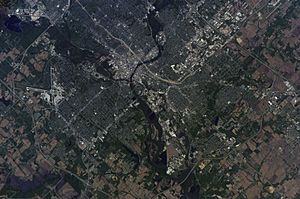
Des Moines covers about 90.65 square miles (234.92 square kilometers). Most of this area is land, with about 1.73 square miles (6.54 square kilometers) covered by water. The city is about 850 feet (266 meters) above sea level where the Raccoon and Des Moines Rivers meet.
In 2005, voters in Des Moines approved a plan to add more land to the city. This helped the city grow and added new residents.
Des Moines Cityscape
The look of Des Moines' downtown changed a lot in the 1970s and 1980s as many new skyscrapers were built. More tall buildings were added in the 1990s, including Iowa's tallest. Before this, the 19-story Equitable Building (built in 1924) was the tallest in the city.
New buildings like the 25-story Financial Center (1973) and the 36-story Ruan Center (1974) changed the skyline. Later, the 33-story Des Moines Marriott Hotel (1981) and the 45-story 801 Grand (1991) were built. 801 Grand is still the tallest building in Iowa.
During this time, new cultural places were also built. These include the Civic Center of Greater Des Moines (1979), the Greater Des Moines Botanical Garden (1979), and the State of Iowa Historical Museum (1987). The Des Moines skywalk system also started in the 1980s. This system is 4 miles (6.4 km) long and connects many downtown buildings, allowing people to walk indoors between them.
In the early 2000s, more big construction projects happened downtown. The new Science Center of Iowa and Blank IMAX Dome Theater opened in 2005. A new main branch of the Des Moines Public Library, designed by a famous architect, opened in 2006.
The World Food Prize Foundation also restored the former Des Moines Public Library building. It now serves as their headquarters, the Norman Borlaug/World Food Prize Hall of Laureates.
Des Moines Climate
Des Moines has a climate with hot, humid summers and cold, dry winters. Summer temperatures often reach the 90s °F (30s °C) and sometimes even 100 °F (38 °C). Spring and summer can be very humid with many thunderstorms. Fall brings nice temperatures and colorful leaves. Winters can be very cold, with temperatures often dropping below 0 °F (–18 °C).
Des Moines gets about 36.5 inches (93 cm) of snow each winter. The city gets about 36.55 inches (928 mm) of rain each year, with most of it falling in the warmer months.
| Climate data for Des Moines International Airport, Iowa (1981–2010 normals, extremes 1878–present ) | |||||||||||||
|---|---|---|---|---|---|---|---|---|---|---|---|---|---|
| Month | Jan | Feb | Mar | Apr | May | Jun | Jul | Aug | Sep | Oct | Nov | Dec | Year |
| Record high °F (°C) | 67 (19) |
78 (26) |
91 (33) |
93 (34) |
105 (41) |
103 (39) |
110 (43) |
110 (43) |
101 (38) |
95 (35) |
82 (28) |
69 (21) |
110 (43) |
| Mean maximum °F (°C) | 53.1 (11.7) |
59.1 (15.1) |
75.0 (23.9) |
84.0 (28.9) |
87.6 (30.9) |
93.2 (34.0) |
96.3 (35.7) |
95.2 (35.1) |
90.4 (32.4) |
82.4 (28.0) |
69.1 (20.6) |
55.8 (13.2) |
97.8 (36.6) |
| Mean daily maximum °F (°C) | 31.0 (−0.6) |
36.1 (2.3) |
49.0 (9.4) |
62.3 (16.8) |
72.4 (22.4) |
81.6 (27.6) |
85.7 (29.8) |
83.8 (28.8) |
76.1 (24.5) |
63.1 (17.3) |
47.9 (8.8) |
34.0 (1.1) |
60.4 (15.8) |
| Mean daily minimum °F (°C) | 14.3 (−9.8) |
18.8 (−7.3) |
29.7 (−1.3) |
41.1 (5.1) |
52.2 (11.2) |
62.0 (16.7) |
66.8 (19.3) |
64.8 (18.2) |
55.2 (12.9) |
43.0 (6.1) |
30.5 (−0.8) |
18.0 (−7.8) |
41.5 (5.3) |
| Mean minimum °F (°C) | −7.8 (−22.1) |
−4.1 (−20.1) |
9.5 (−12.5) |
23.7 (−4.6) |
37.6 (3.1) |
49.1 (9.5) |
56.3 (13.5) |
53.5 (11.9) |
38.0 (3.3) |
26.2 (−3.2) |
12.4 (−10.9) |
−3.6 (−19.8) |
−12.8 (−24.9) |
| Record low °F (°C) | −30 (−34) |
−26 (−32) |
−22 (−30) |
9 (−13) |
26 (−3) |
37 (3) |
47 (8) |
40 (4) |
26 (−3) |
7 (−14) |
−10 (−23) |
−22 (−30) |
−30 (−34) |
| Average precipitation inches (mm) | 1.00 (25) |
1.28 (33) |
2.30 (58) |
3.86 (98) |
4.74 (120) |
4.94 (125) |
4.47 (114) |
4.13 (105) |
3.05 (77) |
2.64 (67) |
2.19 (56) |
1.42 (36) |
36.02 (915) |
| Average snowfall inches (cm) | 8.5 (22) |
7.9 (20) |
5.2 (13) |
1.8 (4.6) |
0 (0) |
0 (0) |
0 (0) |
0 (0) |
0 (0) |
0.4 (1.0) |
2.5 (6.4) |
9.0 (23) |
35.3 (90) |
| Average precipitation days (≥ 0.01 in) | 7.5 | 7.8 | 9.7 | 11.2 | 12.5 | 11.5 | 10.1 | 9.1 | 8.4 | 8.9 | 8.3 | 8.4 | 113.4 |
| Average snowy days (≥ 0.1 in) | 6.5 | 5.6 | 3.2 | 1.0 | 0 | 0 | 0 | 0 | 0 | 0.3 | 2.0 | 6.2 | 24.8 |
| Average relative humidity (%) | 71.0 | 71.3 | 67.9 | 63.2 | 63.0 | 64.8 | 67.7 | 70.0 | 70.9 | 66.5 | 71.0 | 74.6 | 68.5 |
| Mean monthly sunshine hours | 157.7 | 163.3 | 206.0 | 222.2 | 276.0 | 312.1 | 337.8 | 297.9 | 239.8 | 210.0 | 138.5 | 129.2 | 2,690.5 |
| Percent possible sunshine | 53 | 55 | 56 | 56 | 61 | 69 | 73 | 70 | 64 | 61 | 47 | 45 | 60 |
| Source: NOAA (relative humidity and sun 1961−1990) | |||||||||||||
People of Des Moines
Des Moines has the largest African American population in Iowa.
| Historical population | |||
|---|---|---|---|
| Census | Pop. | %± | |
| 1850 | 502 | — | |
| 1860 | 3,965 | 689.8% | |
| 1870 | 12,035 | 203.5% | |
| 1880 | 22,408 | 86.2% | |
| 1890 | 50,093 | 123.5% | |
| 1900 | 62,139 | 24.0% | |
| 1910 | 86,368 | 39.0% | |
| 1920 | 126,468 | 46.4% | |
| 1930 | 142,559 | 12.7% | |
| 1940 | 159,819 | 12.1% | |
| 1950 | 177,965 | 11.4% | |
| 1960 | 208,982 | 17.4% | |
| 1970 | 201,404 | −3.6% | |
| 1980 | 191,003 | −5.2% | |
| 1990 | 193,187 | 1.1% | |
| 2000 | 198,682 | 2.8% | |
| 2010 | 203,433 | 2.4% | |
| 2020 | 214,133 | 5.3% | |
| 2023 (est.) | 210,381 | 3.4% | |
| U.S. Decennial Census | |||
The 2020 United States census counted 214,133 people living in Des Moines. There were 87,958 households and 48,599 families. The population density was about 2,428 people per square mile (937.6 per km2).
The racial makeup of the city in 2020 was:
- 64.54% White
- 11.68% Black or African-American
- 0.69% Native American
- 6.76% Asian
- 0.06% Pacific Islander
- 6.62% from other races
- 9.65% from two or more races
About 15.64% of the population was Hispanic or Latino (of any race).
In 2020, 23.5% of the people were under 18 years old. The average age in the city was 34.8 years.
Des Moines Population in 2010
In the census of 2010, Des Moines had 203,433 people. There were 81,369 households.
The racial makeup of the city in 2010 was:
- 76.4% White
- 10.2% African American
- 0.5% Native American
- 4.4% Asian
- 0.1% Pacific Islander
- 5.0% from other races
- 3.4% from two or more races
About 12.0% of the population was Hispanic or Latino (of any race).
Economy of Des Moines
| Rank | Employer | # of employees |
|---|---|---|
| 1 | Wells Fargo & Co. | 13,500 |
| 2 | UnityPoint Health | 8,026 |
| 3 | Principal Financial Group | 6,600 |
| 4 | MercyOne | 4,276 |
| 5 | Amazon | 3,500 |
| 6 | Nationwide/Allied Insurance | 3,300 |
| 7 | John Deere | 2,884 |
| 8 | Corteva | 2,500 |
| 9 | UPS | 1,721 |
| 10 | Wellmark Blue Cross Blue Shield | 1,600 |
Des Moines is known for its many insurance companies. Companies like Principal Financial Group and Wellmark Blue Cross Blue Shield have their main offices here. Iowa has very low taxes on insurance, which makes it a good place for these businesses. Because of this, Des Moines is sometimes called the "Hartford of the West" or the "Insurance Capital."
Principal Financial Group is one of only two Fortune 500 companies (very large companies) based in Iowa.
Many other big companies also have offices in the Des Moines area, even if their main headquarters are elsewhere. These include Wells Fargo and Voya Financial. The Meredith Corporation, which published popular magazines like Better Homes and Gardens, used to be based in Des Moines.
Other important employers in Des Moines are UnityPoint Health, Mercy Medical Center, MidAmerican Energy Company, and Drake University.
Arts and Culture in Des Moines
Arts and Theater
Des Moines is a cultural hub for Iowa. It has several museums and groups that perform arts. The Des Moines Performing Arts center often hosts traveling Broadway shows and other live professional theater. The Temple for Performing Arts and Des Moines Playhouse are other places for live shows.
The Des Moines Metro Opera has been a cultural part of Des Moines since 1973. They offer educational programs and are one of the biggest performing arts groups in Iowa. Ballet Des Moines started in 2002 and performs three shows each year.
The Des Moines Symphony plays music often at different places. They perform classical concerts and also have fun concerts like their annual Yankee Doodle Pops.
Jazz in July is a yearly event that started in 1969. It offers free jazz shows every day in July at different spots around the city.
Wells Fargo Arena is the main place for sports and concerts in Des Moines. It opened in 2005 and can hold 16,980 people. It hosts big national music acts. It is also home to the Iowa Wolves basketball team, the Iowa Wild hockey team, and the Iowa Barnstormers indoor football team.
The Simon Estes Riverfront Amphitheater is an outdoor concert area on the east side of the Des Moines River. It hosts music events like the Alive Concert Series.
The Des Moines Art Center has buildings designed by famous architects. It shows art exhibits and offers art classes. The center has a collection of artwork from the 1800s to today.
The Pappajohn Sculpture Park opened in 2009. It displays 24 sculptures given by local art lovers, John and Mary Pappajohn. Near the park is the Temple for Performing Arts, a cultural center. Next to the Temple is the Central Library, designed by a famous English architect.
Salisbury House and Gardens is a historic house museum with 42 rooms. It's on 10 acres (4 hectares) of woods. Built in the 1920s, it looks like an old English house and has real 16th-century English wood. It also holds a very important collection of art, tapestries, furniture, and rare books. Salisbury House is listed on the National Register of Historic Places.
Hoyt Sherman Place is a mansion built in 1877. It was Des Moines' first public art gallery and has a special collection of art from the 1800s and 1900s. Its theater is used for many cultural performances.
Attractions in Des Moines

The Iowa State Capitol building is a popular sight. It has a 275-foot (84-meter) dome covered in 23-karat gold. Four smaller domes are around the main one. The Capitol holds the governor's offices and the state legislature. Inside, you can see a grand staircase, a large mural, and a model of the USS Iowa. You can take guided tours.
The Capitol grounds have memorials for soldiers who served in different wars. The West Capitol Terrace is a 10-acre (4-hectare) park with gardens and a granite map of Iowa.
Iowa's history is shown at the State of Iowa Historical Museum. This modern building has exhibits about Iowa's past, including native wildlife, American Indian items, and pioneer tools.
Terrace Hill is a historic home and the official residence of Iowa's governor. This beautiful 1869 house was built by Iowa's first millionaire. It has been restored to look like it did in the late 1800s. You can take tours of the house.
The Science Center of Iowa and Blank IMAX Dome Theater has 110,000 square feet (10,219 square meters) of space. It offers seven hands-on learning areas, live shows, and activities for all ages. It has an IMAX Dome Theater and a Star Theater.
The Greater Des Moines Botanical Garden is an indoor garden with over 15,000 exotic plants. It has one of the largest collections of tropical and desert plants in the Midwest. Nearby are the Robert D. Ray Asian Gardens, named after a former governor who helped many Vietnamese refugees come to Iowa.
Blank Park Zoo is a 22-acre (9-hectare) zoo on the south side of Des Moines. It has exhibits like a tropical rain forest and an Australian Outback area.
The Iowa Primate Learning Sanctuary is a place for scientific research. It houses bonobos and orangutans to study how they think and communicate.
The East Village is on the east side of the Des Moines River. It has a mix of old buildings, cool restaurants, shops, and art galleries.
Adventureland Park is an amusement park in Altoona, just northeast of Des Moines. It has over 100 rides, shows, and attractions, including six rollercoasters. Also in Altoona is Prairie Meadows Racetrack and Casino, where you can find gambling and horse racing.
Living History Farms in Urbandale is a 500-acre (2 square kilometer) outdoor museum. People dressed in old costumes show what life was like for early Iowans. You can see a 1700 Ioway Indian village, an 1850 pioneer farm, and an 1875 frontier town.
Wallace House was the home of Henry Wallace, a leader in farming and conservation. This restored 1883 house shows exhibits about four generations of the Wallace family.
Historic Jordan House in West Des Moines is a Victorian home built in 1850. It was part of the Underground Railroad, a secret network that helped enslaved people escape to freedom. Today, it has 16 rooms from that time, a railroad museum, and a museum about the Underground Railroad in Iowa.
Festivals and Events in Des Moines
Des Moines hosts many popular cultural events. These include the annual Des Moines Arts Festival in June, Metro Arts Jazz in July, the Iowa State Fair in August, and the World Food & Music Festival in September. The Downtown Farmers' Market is held every Saturday from May to October and brings many visitors.
Local parades include the Saint Patrick's Day Parade, Drake Relays Parade, and the Iowa State Fair Parade.
Other yearly events include: Des Moines Beer Week, 80/35 Music Festival, ArtFest Midwest, Blue Ribbon Bacon Fest, CelebrAsian Heritage Festival, Des Moines Pride Festival, and Oktoberfest.
Museums in Des Moines
- Des Moines Art Center
- Jordan House Museum
- Hoyt Sherman Place
- Salisbury House
- Science Center of Iowa
- State Historical Society of Iowa
- Terrace Hill – The official home of Iowa's governor
- Wallace House Museum
- World Food Prize Hall of Laureates
Sports in Des Moines
Des Moines has professional minor league teams in several sports: baseball, basketball, hockey, indoor football, and soccer. It is also home to the sports teams of Drake University, which play in NCAA Division I.
The Des Moines Menace soccer club plays its home games at Valley Stadium in West Des Moines. Des Moines United FC also plays soccer at Valley Stadium.
Des Moines is home to the Iowa Cubs baseball team. The I-Cubs are the Triple-A team for the major league Chicago Cubs. They play their home games at Principal Park.
Wells Fargo Arena is home to the Iowa Barnstormers (indoor football), the Iowa Wild (hockey), and the Iowa Wolves (basketball). The Barnstormers were famous for having future NFL Hall of Famer Kurt Warner as their quarterback. The Iowa Wild are the AHL team for the National Hockey League's Minnesota Wild.
The Des Moines Buccaneers hockey team plays at Buccaneer Arena in Urbandale.
Drake University's teams, the Bulldogs, play in NCAA Division I. Their home games are mostly at Drake Stadium and Knapp Center. Drake Stadium is famous for hosting the Drake Relays every April.
The Vikings of Grand View University also compete in sports in Des Moines. They were national champions in football in 2013.
The Principal Charity Classic, a golf event, is held at Wakonda Club. The IMT Des Moines Marathon takes place in the city every October.
| Club | Sport | League | Venue | City | Founded |
|---|---|---|---|---|---|
| Iowa Barnstormers | American football | Indoor Football League | Wells Fargo Arena | Des Moines | 1995 (2008) |
| Iowa Cubs | Baseball | International League, Minor League Baseball | Principal Park | Des Moines | 1969 |
| Iowa Wolves | Basketball | NBA G League | Wells Fargo Arena | Des Moines | 2007 |
| Des Moines Buccaneers | Ice hockey | United States Hockey League | Buccaneer Arena | Urbandale | 1980 |
| Iowa Wild | Ice hockey | American Hockey League | Wells Fargo Arena | Des Moines | 2013 |
| Des Moines Menace | Soccer | USL League Two | Valley Stadium | West Des Moines | 1994 |
| Des Moines United FC | Soccer | National Premier Soccer League | Valley Stadium | West Des Moines | 2021 |
| Drake Bulldogs | Multi | NCAA Division I, Missouri Valley Conference | Drake Stadium, Knapp Center | Des Moines | 1881 |
Parks and Recreation in Des Moines
Des Moines has 76 city parks and three golf courses. It also has three aquatic centers, five community centers, and three swimming pools. The city has 45 miles (72 km) of trails for walking and biking. Greenwood Park was the first major park, bought in 1894.
The Principal Riverwalk is a park area being built along the Des Moines River downtown. It will have a 1.2-mile (1.9 km) trail connecting the east and west sides of downtown with two pedestrian bridges. The Riverwalk also includes the Brenton Skating Plaza, which is open for ice skating in winter.
Gray's Lake is part of the 167-acre (67.6-hectare) Gray's Lake Park. It has boat rentals, a fishing pier, and floating boardwalks. The main part of the park is the lighted 1.9-mile (3.1 km) Kruidenier Trail, which goes all the way around the lake.
The Neil Smith and John Pat Dorrian Trails are paved trails that start downtown along the Des Moines River. They connect Gray's Lake north to Saylorville Lake, Big Creek State Park, and trails in Ankeny.
West of Gray's Lake is the 1,500-acre (607-hectare) Des Moines Water Works Park. This park is along the Raccoon River. The Des Moines Water Works Facility, which gets the city's drinking water from the Raccoon River, is inside this park. The park's trails connect to downtown Des Moines and to the trails of the western suburbs like West Des Moines and Clive.
Education in Des Moines

The Des Moines Public Schools district is the largest school district in Iowa. It has 32,062 students enrolled. The district has 63 schools: 38 elementary schools, eleven middle schools, five high schools (East, Hoover, Lincoln, North, and Roosevelt), and ten special programs. Some parts of the city are served by other school districts.
Des Moines is also home to three four-year private colleges: Drake University, Grand View University, and Mercy College of Health Sciences. The University of Iowa has a satellite campus downtown. Iowa State University offers business classes downtown. Des Moines Area Community College is the area's community college. The city also has Des Moines University, a medical school.
Media in Des Moines
Radio Stations
Many radio stations broadcast in the Des Moines area. iHeartMedia owns five stations, including WHO 1040 AM, a popular news/talk station where former President Ronald Reagan once worked.
Cumulus Media owns five stations, including KGGO 94.9 FM (classic rock) and KHKI 97.3 FM (country music).
Saga Communications owns nine stations, including KIOA 93.3 FM (oldies) and KSTZ 102.5 FM (adult contemporary hits).
Non-commercial radio stations include KDPS 88.1 FM, run by the Des Moines Public Schools, and KWDM 88.7 FM, run by Valley High School. Iowa Public Radio also broadcasts several stations in the area, including WOI 640 AM, which is a National Public Radio station.
Television Stations
The Des Moines-Ames area has many TV stations. Commercial stations include CBS affiliate KCCI channel 8, NBC affiliate WHO-DT channel 13, and Fox affiliate KDSM-TV channel 17. ABC affiliate WOI-TV channel 5 and CW affiliate KCWI-TV channel 23 are also in the area.
Non-commercial stations include KDIN channel 11, which is the local PBS station and part of the Iowa Public Television network. Mediacom is the main cable TV provider in Des Moines.
Newspapers and Magazines
The Des Moines Register is the city's main daily newspaper. Other weekly newspapers include Juice and Cityview. The Des Moines Business Record is a business newspaper.
Music from Des Moines
Des Moines is where several famous bands and artists started. Slipknot, a popular heavy metal band, was formed in 1995. They are known worldwide for their unique sound.
Stone Sour, an American rock band, was started in 1992 by Corey Taylor, who later became the lead singer for Slipknot.
Vended, another American heavy metal band, was formed in 2018 by Griffin Taylor and Simon Crahan, who are the sons of Corey Taylor and Shawn "Clown" Crahan from Slipknot. They have been gaining success and released their first album in 2024.
Transportation in Des Moines
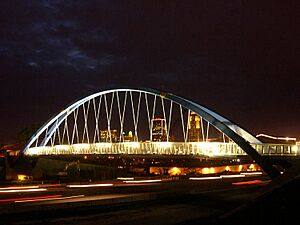
Des Moines has a large skywalk system downtown. It has over four miles (6.4 km) of enclosed walkways, making it one of the biggest in the United States. These skywalks connect many downtown buildings.
Major highways like Interstate 235 (I-235), I-35, and I-80 pass through the Des Moines area. I-35 and I-80 join together on the northern side of the city, while I-235 goes directly through Des Moines.
Des Moines' public transportation system, called DART (Des Moines Area Regional Transit), uses only buses. These buses have regular routes within the city and express routes to the suburbs.
Even though Des Moines used to be a big train center, it does not have direct passenger train service today. The closest Amtrak train station is in Osceola, about 40 miles (64 km) south of Des Moines.
The Des Moines International Airport (DSM) is in the southern part of Des Moines. It offers flights to many places within the United States.
Sister Cities of Des Moines
The Greater Des Moines Sister City Commission helps Des Moines have special relationships with cities around the world. These "sister cities" include:
 Kōfu, Japan (since 1958)
Kōfu, Japan (since 1958) Saint-Étienne, France (since 1985)
Saint-Étienne, France (since 1985) Shijiazhuang, China (since 1985)
Shijiazhuang, China (since 1985) Pristina, Kosovo (since 2018)
Pristina, Kosovo (since 2018) Kuala Terengganu, Malaysia (since 1987)
Kuala Terengganu, Malaysia (since 1987)
Images for kids
See also
 In Spanish: Des Moines para niños
In Spanish: Des Moines para niños


